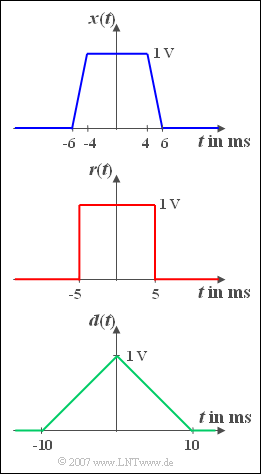Exercise 3.4Z: Trapezoid, Rectangle and Triangle
Three different pulse shapes are considered. The pulse ${x(t)}$ is trapezoidal. For $| t | < t_1 = 4 \,\text{ms}$ the time course is constant equal to ${A} = 1\, \text{V}$. Afterwards, ${x(t)}$ drops linearly to the value zero until the time $t_2 = 6\, \text{ms}$ . With the two derived system quantities, namely
- $$\Delta t = t_1 + t_2$$
- and the so-called roll-off factor (in the time domain)
- $$r_t = \frac{t_2 - t_1 }{t_2 + t_1 }$$
is the spectral function of the trapezoidal pulse:
- $$X( f ) = A \cdot \Delta t \cdot {\mathop{\rm si}\nolimits}( {{\rm \pi} \cdot \Delta t \cdot f} ) \cdot \hspace{0.1cm}{\mathop{\rm si}\nolimits}( {{\rm \pi}\cdot \Delta t \cdot r_t \cdot f} ).$$
Furthermore, the rectangular momentum ${r(t)}$ and the triangular momentum ${d(t)}$ are also shown in the graph, both of which can be interpreted as limiting cases of the trapezoidal momentum ${x(t)}$ .
Hints:
- This exercise belongs to the chapter Fourier Transform Laws.
- You can check your results using the two interactive applets Impulses and Spectra sowie Frequenzgang und Impulsantwort .
Questions
Solution
(2) Richtig sind die Lösungsvorschläge 2 und 3:
- Der Spektralwert bei $f = 0$ beträgt $A \cdot \Delta t = 10 \,\text{mV/Hz}$.
- Da ${X(f)}$ reell ist und sowohl positive als auch negative Werte annehmen kann, sind nur die zwei Phasenwerte $0$ und $\pi$ möglich.
- Nullstellen gibt es aufgrund der ersten si-Funktion bei allen Vielfachen von $1/\Delta t = 100\, \text{Hz}$.
- Die zweite si-Funktion führt zu Nulldurchgängen im Abstand $1/(r_t \cdot \Delta t) = 500 \,\text{Hz}$. Diese fallen exakt mit den Nullstellen der ersten si-Funktion zusammen.
(3) Alle Lösungsvorschläge sind zutreffend:
- Mit der äquivalenten Impulsdauer $\Delta t = 10 \,\text{ms}$ und dem Rolloff-Faktor $r_t = 0$ erhält man: $R( f ) = A \cdot \Delta t \cdot {\mathop{\rm si}\nolimits} ( {{\rm{\pi }} \cdot \Delta t \cdot f} ).$
- Daraus folgt $R( f = 0) = A \cdot \Delta t = X( f = 0).$
(4) Hier sind die Lösungsvorschläge 1 und 3 zutreffend:
- Beim Dreieckimpuls ist der Rolloff-Faktor $r_t = 1$.
- Die äquivalente Impulsdauer ist $\Delta t = 10 \,\text{ms}$. Daraus folgt $D( f ) = A \cdot \Delta t \cdot {\mathop{\rm si}\nolimits} ^2 ( {{\rm{\pi }} \cdot \Delta t \cdot f} )$ und $D( f = 0) = A \cdot \Delta t = X( f = 0)$.
- Da ${D(f)}$ nicht negativ werden kann, ist die Phase $[{\rm arc} \; {D(f)}]$ stets Null. Der Phasenwert $\pi$ $(180°)$ ist also bei der Dreieckform nicht möglich.
